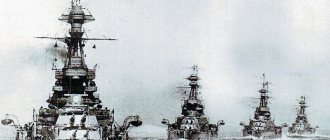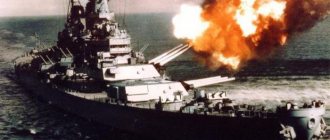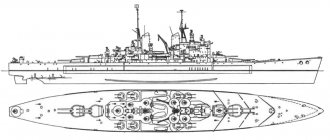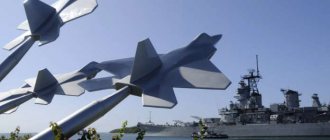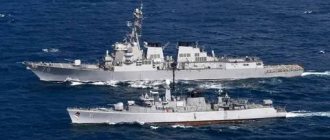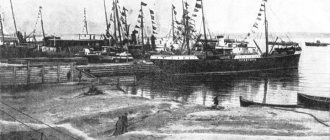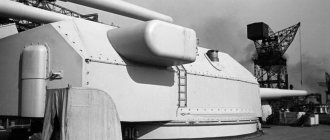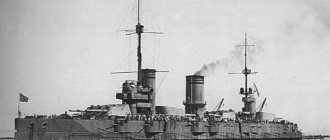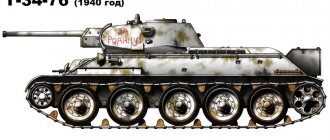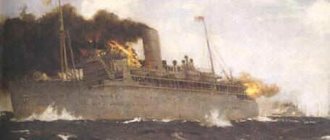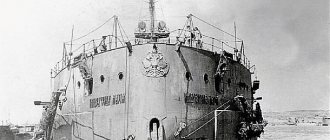Reservations, armament "Queen Elizabeth"
The ship's protection was strengthened in some places, but in some places the armor had to be weakened - the deck was covered with plates only 6 mm thick. Turbogenerators ensured uninterrupted operation of all electrical devices. The water desalination system was improved - up to 650 tons per day. The speed reached 25 knots.
Main caliber of 381 mm guns 15″/42cal Mk I
The armament consisted of the following types of equipment:
- 8 naval 381-mm 15″/42cal Mk I guns, which guaranteed increased firing range and destruction power. It was decided to remove one main caliber turret. Calculations showed that a salvo of 8 new 15-inch guns would exceed the total weight of the previous ten 13.5-inch guns. The freed up space could be used to accommodate additional boilers, providing increased speed. This solution turned out to be quite successful, and the experience was used in subsequent developments.
- 16 152 mm Mk XII mine countermeasures. 12 guns repeated their location on the Iron Duke. At the same time, 4 more casemate installations were added - 2 on each side on the main deck. However, the main problem with the placement of secondary weapons was never solved - when the sea was rough, the installations were flooded. Over time, some of them had to be dismantled.
- 2 anti-aircraft guns with a caliber of 76 mm;
- 4 underwater torpedo tubes 533 mm.
Battleship Queen Elizabeth. Noble blood frozen in metal
The optics refracted the silhouette of the battle cruiser Von der Tann, the flashes of salvos and the breakers of torpedoes.
Combat debut off the coast of Jutland! A quarter of a century is just a moment. The cliffs of Narvik, snow charges and flying wreckage of destroyers flashed through the sights. Change of course - Mediterranean Sea. "Giulio Cesare" is on the horizon. Volleys from extreme distances, unexpected success. The enemy retreats, leaving a trail of smoke astern.
The roar of guns shakes the coastline, and heavy shells fall on naval bases in Libya and Albania.
Radar contact in pitch darkness. The ship fires point-blank, tearing apart the Zara, Sola and Fiume with its main caliber.
Rays of the setting sun and stones of the Neolithic era. The last defenders of the island of Crete. The roar of dive bombers, anti-aircraft gun shots. Bombs hit the deck. The new course is to the east, through the Suez Canal.
An island lost in the vast ocean. Military base or luxury yacht club? Jazz plays in Pearl Harbor and peaceful life continues.
Shipyard in Washington state, alien American accent. The damage has been repaired and it is impossible to return along the previous route. Japan declared war.
The ship heads south, towards the beaches of Sydney, Australia. And again - the vast expanse of the Pacific and Indian oceans. The pursuit of the Japanese connection. On the log - 160 thousand miles traveled, on the calendar - winter of 1942, on the flagpole - White Ensign. Royal Navy flag.
The aroma of exotic spices from the island of Ceylon and the yellow dust of the Suez Canal. The coast of Italy trembles under the shots of 15-inch cannons. 1943, fire support for landing operations Avalanche and Husky. Black crosses are flying in the sky, guided bombs are rushing towards the ship.
Explosions and 5,000 tons of water received. But this is a British ship, sir. Stay in place and fight for survivability. Evacuation plan: Malta - Gibraltar - Rosyth.
Sleepy morning in Normandy. Ancient guns were the first to notify the shore of the beginning of the invasion of Europe. Large-caliber landmines plowed up a section of the Sword beach.
The battleship continued to fire throughout the summer and autumn of 1944, hitting mines and gradually moving north along the coast. His last combat mission was the shelling of targets in the Netherlands.
At this point you should take a breath and find the right words about one of the most active ships in history. A participant in both world wars, who went through an insane number of vicissitudes.
For your attention: the battleship "Warspite" (Warspite, the anger of war). One of the five representatives of the Queen Elizabeth type.
Knights and aristocrats
Direct descendants in the male line of the famous Dreadnought.
With such a pedigree, any path and opportunity was open to them. "Queen" is the oldest of the British battleships that took part in the Second World War. Designed at the beginning of the century, when boilers were fired with coal and oil was considered exotic. Two decades later, they were still considered a worthy opponent.
There were reasons for this.
The offspring of noble blood had little in common with their peers from “dysfunctional families.”
There will be a tough example. For fun, take a look at our “Baltic long-term construction projects”. Supporters of the greatness of Tsarist Russia will look away in shame. Meanwhile, Queen Elizabeth and Sevastopol entered service in the same year (1914).
Critics and sympathizers will probably argue that “Queen” hit everyone equally. "Ostfriesland", "Kaiser" and Italian "Andrea Doria". Everything became outdated in an instant. In general, everything was fine. Until that Englishman was ahead of his time.
The “Queen” level was partially “taken” only in the Bayern project. But for a similar main caliber, the Germans paid with half the power of the power plant.
The Bayern series consisted of two units built. Further, during the period under review, no one made any attempts to build high-speed battleships with a main caliber of 381 mm. Naval commanders and engineers began to discuss such issues only towards the end of the war. And the overall balance of characteristics achieved in the Queen Elizabeth project remained for a long time the “upper bar” for the entire class of battleships.
Comparison of the appearance and size of British battleships - from the Dreadnought to the late Vanguard, which entered service after the end of World War II.
The era of international restrictions contributed to further successes.
The value of the main caliber of European fleets froze forever at around 15 inches. An amazing story happened to the British fleet itself. For two decades, Queen Elizabeth retained a number of significant advantages over all new types of battleships!
The following Revenge-type LCs were planned to be made into a “budget” version of the Queens. Parity in firepower was achieved, at the cost of simplifying the design and reducing speed.
Built during the interwar period, Nelson (1927) fell victim to contractual restrictions. The superiority in combat qualities was not so obvious. "Queen" turned out to be not only faster than the new battleships, but could, for example, boast of having protected ends.
The fast "King George V" (1939) had a congenital artillery defect. Uncertainty with international restrictions and haste in anticipation of a “big war” led to the choice of a 14-inch main gun. Which later became the object of criticism more than once or twice.
Throwing with a choice of caliber had a known result. The last and most advanced in its class, Vanguard (1946), was armed with 15-inch caliber guns. Those that were created at the beginning of the century for the Queen Elizabeth project...
The British 15-inch Mark I is considered one of the most successful large-caliber naval guns. Expectedly powerful and balanced in all respects that characterize such weapons.
With these guns, the British fleet smeared opponents from different eras. From the High Seas Fleet to the Kriegsmarine ships with the black swastika. He hit the walls of Turkish forts (1915) and Japanese fortifications in the Andaman Islands (1945).
In addition to the Queens, five series of battlecruisers and battleships were armed with such guns. And each combat episode showed the following.
15" remained important in both world wars
In 1941, the German Scharnhort and Gneisenau refused to approach the convoy SL-67, which was covered by the battleship Malaya.
The two of them ran away from the battle cruiser Repulse, having received a 15-inch “blank” in the forehead. And they did not dare to approach the Ramilles. Perhaps the most “unconvincing” of the Mark I gun carriers. An outdated and unmodernized battleship of the Rivenge class.
The Germans were not confident that these antiques would be dealt with quickly. And a protracted firefight involving 381-mm cannons threatened the Scharnhorst-type LK (LKR) with unpredictable and painful consequences.
The Mark I impressed even the most protected ships in history! This gun, which fired 880 kg shells, could “take out” weaker opponents with one hit.
In the battle of Cape Stilo, a shell fired by Warspite destroyed the Cesare citadel. Critical elements (ammunition, ammunition) were unaffected, but the destruction, debris and fires were enough for the Italian battleship to immediately slow down and leave the battle. Losses in killed and wounded amounted to more than 100 people!
This incident, known as the "shot off Calabria", became a record for naval battles.
"Four battleships, seven minutes of fire - one hit." (Admiral Cunningham)
Hitting a moving ship from 24 kilometers away was an accident. But the effect of being hit by an 880-kg projectile was quite expected.
The 15-inch caliber turned the Queens into the most powerful ships of the First World War. And it was only thanks to him that the “Queens” retained their importance during the Second World War.
Eight 381 guns fired a larger broadside than ten 343 mm guns on the battleships Iron Duke, King George V or Orion. In numbers: 6,804 kg versus 6,250 kg.
This circumstance made it possible to abandon the fifth main caliber turret in the middle part of the hull. The place of which was taken by the power plant mechanisms.
The formation of battleships "Queen Elizabeth" was intended to become a "fast wing" of the battle fleet, operating in the same ranks with battle cruisers.
The power of the power plants at its peak exceeded 70 thousand hp. s., and the speed reached 24 knots.
The Queens' technical records left the admirals in a bad mood. To fully comply with the plan, even higher indicators were required, impossible for that time. Such values were achieved much later, in the 1930s and 1940s. When the line between the concepts of “battle cruiser” and “battleship” became blurred.
Speed still played a role. "Queens" were assigned to the same formation with battlecruisers. And they were able to provide belated support to the LCR in the Battle of Jutland.
Possessing superior security, the German fleet managed to inflict significant losses on the British. Victory with a “nil” score was approaching, but then columns of water shot up next to the “Panzerkreuzers,” one and a half times higher in height than the splashes from the fall of 343-mm shells.
Nice meeting you
The illustration shows the result of a 381-mm shell hitting the battlecruiser Von der Tann from the battleship Valient. The shell pierced the 100-mm belt at the tip, like foil, and exploded inside, damaging the steering gear. The uncontrollable German “rolled out” in front of the approaching armada of British battleships, risking repeating the fate of the Blucher on the Dogger Bank. However, the emergency party managed to restore control. Another consequence of the hit was the torn off slab of the underwater belt. About 600 tons of water entered the hull, which led to a list.
Damage to the battlecruiser Derflinger.
The British were in euphoria for too long about ships with a 381-mm main caliber. In the 1920s, having lost the ability to lay down new battleships, they discovered that the fighting core of the fleet was still made up of the Queens from the early 1910s.
In fact, the situation was not critical. Queen Elizabeth's potential lasted for a long time. With timely modernization, battleships of this type fully met the requirements of the era and could even be superior to their competitors in some ways. The power plant changed, boules, anti-aircraft guns and modern fire control equipment appeared. By 1941, the lead Queen was already equipped with three radars and a radio identification system for friend or foe.
This caring attitude had its results. Unlike many younger ships, the Kings and Queens greeted the news of the start of the war fully armed and in full combat readiness.
"Queen Elizabeth" and "Warspite" served until the very end as ships of the line. Barham was lost in 1941. Malaya was damaged and was relegated to training in 1943. "Valient" lasted longer, its path was interrupted by a non-combat incident.
Warspite, of course, gained the greatest fame. Even one such fighter justified the existence of the entire Queen Elizabeth series.
In fact, each of the representatives of the series honestly fulfilled the assigned tasks. Inspired and limited the enemy’s actions in the theater of operations. He steadfastly endured battle wounds and snapped back fire. Covered convoys and took part in battles of linear forces. First - in the waters of the metropolis and in the Mediterranean Sea, where the Italian fleet was considered the main enemy. But in fact – saboteurs of the “black prince” Borghese and Luftwaffe planes.
The lead "Queen" and "Valient" managed to take part in combat operations in the Pacific and Indian Oceans. The last parade for the Valient came when it was put into repair. The floating dock, falling apart, almost dragged the battleship to the bottom.
Epilogue in the steampunk genre
Time has not been kind to the once strongest ships.
The former favorites gradually lost their dominance. It was becoming increasingly difficult for them to recover from injuries, and their technical appearance had long ceased to correspond to the times. The Queens would not be fast enough to perform the role of “boss” in carrier task forces. Their vertical protection could still meet the standards of World War II battleships, but the thickness of their armored decks left much to be desired. As the death of the Barham showed, the design of the 1910s could not effectively withstand the effects of torpedo weapons. Partly due to the small size of the battleships themselves.
The Queens had no concept of a universal medium caliber. And the total electrical power of turbo and diesel generators was almost 7 times lower than that of the American Iowas.
They continued to be considered rank 1 units due to their unique weapons. But the saturation of the fleet with new battleships of the King George V class removed the need for continued operation of veterans. When damage occurred, they tried to put them into reserve. The naval enemy himself also disappeared. The last active Kriegsmarine battleship was sunk in December 1943 (Scharnhorst).
All ships of this type, except for the lost battleship Barham, were immediately scrapped after the war. But Warspite finished the most enchantingly of all.
The Warspite died laughing at the gloom of the cutting docks. In 1947, while being towed, it ran aground and clung to the underwater rocks so tightly that it was impossible to move it. They began to dismantle the battleship right in the water. The last remains of the Warspite were lost to sight due to storms and waves in 1955.
Rest at the bottom, undefeated knight
The history of the battleships Queen Elizabeth contains a lot of impressive information. But one point is interesting. Nowadays, it has become common to see huge frigates armed with a water cannon and a machine gun. And the designers cannot make room for an extra dozen missiles.
How did they manage to “stuff” 4,500 tons of weapons and 8,750 tons of armor 110 years ago, with a crew of 1,200 people? and a steam turbine unit that developed the power of half the nuclear Orlan, in a hull with a standard displacement of 28 thousand tons?
What capabilities would a modern missile cruiser acquire while maintaining the hull and level of security of the Queen Elizabeth?
I invite readers to leave their comments.
Service
It was planned to build 6 battleships of this class. In fact, only 5 ships were laid down. Four of them took part in the Battle of Jutland in 1916. The radius of destruction was more than 17 km, this distance exceeded the firing range of German military equipment. Nevertheless, the enemy managed to get close and damaged three Queen Elizabeth-class battleships. In the post-war years, they underwent modernization and received a number of improvements in the field of weapons and electronics.
During the early years of World War II, the Barham was attacked by the German submarine U-331. 862 crew members went under water along with the ship. However, before this, the battleship took part in the Battle of Dakar, where it damaged a French ship controlled by opponents. In 1941, he took part in the sinking of an Italian heavy cruiser.
The remaining four dreadnoughts participated in many famous battles, each of them being damaged by the enemy. Thus, the lead ship Queen Elizabeth was mined by Italian divers in December 1941 off the coast of Egypt. He spent the next year and a half at the repair docks in Alexandria, the USA and the UK. Having recovered, the ship continued to participate in military battles. After the end of the war, all of the described battleships were removed from service.
Where it all started
You may be interested in: Substances that have a sour taste. Substances that affect taste
At the beginning of the 20th century, the number of military clashes between world powers increased exponentially, and this, in turn, led to the fact that the quality of their weapons and the number of their military equipment also grew inexorably, in particular, there was an active improvement in the construction of warships. A turning point in the development of military justice was the creation of battleships.
What is a battleship?
You may be interested in: Father-in-law: the meaning of the word. Who is the father-in-law?
A battleship (short for “ship of the line”) is a class of armored military ships equipped with heavy artillery guns. The length of these vessels varied from 150 to 280 meters, and their displacement reached 70 tons. Created to destroy and exterminate enemy ships, battleships were direct evolutionary successors of battleships. The progenitor of the battleship class was the English ship Dreadnought, which was born in 1906. The Dreadnought had a steam turbine power plant, which provided it with an enormous speed at that time - 21 knots (converting knots to kilometers, we can say that its speed then reached 39 km/h). The construction of the Dreadnought and the use of its advantages at sea significantly changed the state of affairs in the naval arms race and in the field of shipbuilding in general. So, following the British, one after another, countries began to create battleships with single-caliber guns and modernize them, wanting to overtake their rivals. Ships of this type received the name of their ancestor - “dreadnoughts”, and more improved versions - “superdreadnoughts” and “superdreadnoughts”.
Series features
The battleship Queen Elizabeth and similar ships, as mentioned earlier, differed from their predecessors and had a number of features. First of all, these battleships had guns with a 15-inch caliber - enormous power at that time. Secondly, the super-dreadnoughts of this series became the first large ships to run on oil fuel; previously, battleships of this size were powered only by steam. Thirdly, the speed of the Queen Elizabeth class battleships reached 24 knots (if you convert knots to kilometers per hour, it will be clear that the speed of such ships reached 45 km/h). In addition, these ships had the highest metacentric height in the entire British fleet, this perfectly ensured their stability and helped withstand wave impacts and strong gusts of wind.
The further fate of the battleship
In 1915, the battleship Queen Elizabeth was sent to the Dardanelles to support the landings during the Battle of Gallipoli; during this mission, the British battleship sank a Turkish transport in the shallow Nagara Bay with fire from the third salvo. Despite her high speed and super-heavy guns, the lead ship was unable to participate in the largest battle of the First World War - the Battle of Jutland, but in 1917 she became the flagship of Admiral David Beatty, commander of the Grand Fleet.
The Second World War found the battleship Queen Elizabeth at the time of modernization. Until 1941, the Queen Elizabeth served as part of the British Home Fleet. But in December of the forty-first year, while parked in Alexandria, the battleship was seriously damaged by Italian combat swimmers using magnetic mines, which led to the formation of a large hole and the flooding of many compartments. After repairs, the battleship was sent to the Indian Ocean and from the beginning of 1944 became the flagship of the Eastern Fleet, making several raids on the islands of Indonesia and Malaysia. In July 1945, the battleship Queen Elizabeth made her last military campaign, went into reserve in August of the same year and was sold for scrap a couple of years after that.
Source
